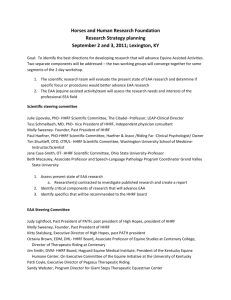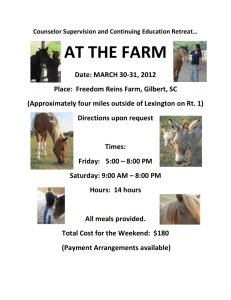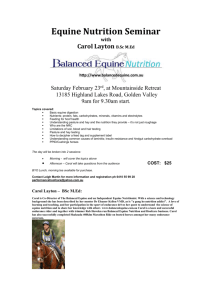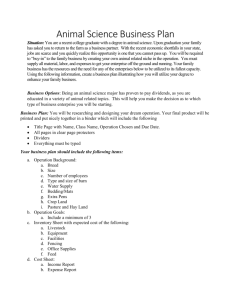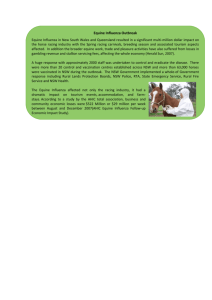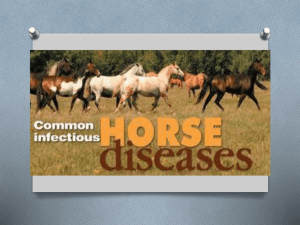Region 5 Tips for Continuing Education in EAAT
advertisement
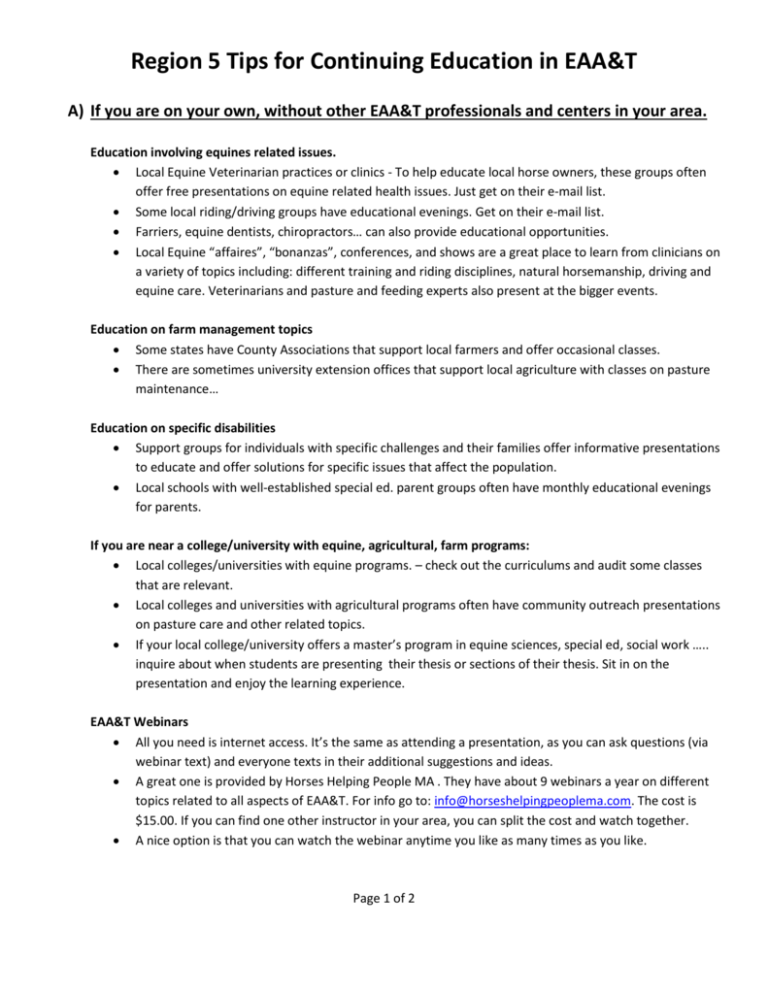
Region 5 Tips for Continuing Education in EAA&T A) If you are on your own, without other EAA&T professionals and centers in your area. Education involving equines related issues. Local Equine Veterinarian practices or clinics - To help educate local horse owners, these groups often offer free presentations on equine related health issues. Just get on their e-mail list. Some local riding/driving groups have educational evenings. Get on their e-mail list. Farriers, equine dentists, chiropractors… can also provide educational opportunities. Local Equine “affaires”, “bonanzas”, conferences, and shows are a great place to learn from clinicians on a variety of topics including: different training and riding disciplines, natural horsemanship, driving and equine care. Veterinarians and pasture and feeding experts also present at the bigger events. Education on farm management topics Some states have County Associations that support local farmers and offer occasional classes. There are sometimes university extension offices that support local agriculture with classes on pasture maintenance… Education on specific disabilities Support groups for individuals with specific challenges and their families offer informative presentations to educate and offer solutions for specific issues that affect the population. Local schools with well-established special ed. parent groups often have monthly educational evenings for parents. If you are near a college/university with equine, agricultural, farm programs: Local colleges/universities with equine programs. – check out the curriculums and audit some classes that are relevant. Local colleges and universities with agricultural programs often have community outreach presentations on pasture care and other related topics. If your local college/university offers a master’s program in equine sciences, special ed, social work ….. inquire about when students are presenting their thesis or sections of their thesis. Sit in on the presentation and enjoy the learning experience. EAA&T Webinars All you need is internet access. It’s the same as attending a presentation, as you can ask questions (via webinar text) and everyone texts in their additional suggestions and ideas. A great one is provided by Horses Helping People MA . They have about 9 webinars a year on different topics related to all aspects of EAA&T. For info go to: info@horseshelpingpeoplema.com. The cost is $15.00. If you can find one other instructor in your area, you can split the cost and watch together. A nice option is that you can watch the webinar anytime you like as many times as you like. Page 1 of 2 B) If you have other EAA&T professionals or PATH member centers in your area. Create a “Continuing Education Coop”. Over the course of the year, individuals or centers take turns providing presentations on different topics. This can be as simple as renting a DVD covering different EAA&T related topics such as, ”Saddle Fit” or “The Out of Sync Child”. As a group, watch the DVD, discuss, and then try some hands on activities such as fitting a few horses with saddles or discussing participants with sensory issues and what helps them at the farm. EAA&T professionals can take turns researching a favorite topic and then presenting it to others. Invite a panel of participants or their family members in to present as a panel. For example: 3 or 4 parents of children on the ASD have much to share on techniques that work or that “bag of tricks”. Invite a speech or behavior therapists who treat some of your participants, to come out and observe a class and then give a presentation. Take a typical program activity and turn it into a brainstorming continuing ed. opportunity. For example: if you are running low on creative ideas for lessons, invite everyone to bring their ideas and props to present, share, and brainstorm new ideas. One group had a ball getting creative and making PECS, new props (such as arrows) and taking pictures of props. They laminated the pictures and added Velcro or magnets to put on the newly created felt boards and magnetic white boards that they set up as permanent fixtures in the arena. They had a great time exploring their new found creative sides and discussing ways to incorporate their new materials to help their riders engage in the lessons and practice riding skills. Invite a PT and OT to observe and discuss the body mechanics of typical riding skills i.e. using rein aids, posting, maintaining the 2 pt. position, balancing through the back-up. Very insightful! Ask your farrier, equine dentist, chiropractor… to consider providing aneducational opportunities. They often appreciate the opportunity to network with others who may use their services. We all need to brush up on our knowledge and skills. Why not take an equine evaluation, pull out the handouts we all collect over the years on confirmation, gaits… and discuss each phase of the evaluation? Put tape on 2 or 3 willing volunteers and watch how the horse’s movement affects each person’s body as the ride. C) If you are a PATH Intl. Premier Accredited Center Please consider taking a leadership role in your area by supporting other local PATH professionals and their programs. By assuming a philosophy of outreach, inclusion and genuine support for other centers and programs, you will positively affect the EAA&T industry. Whenever appropriate, open your Continuing Education presentations to others. Every center starts in the same place, small and without many resources. Please share your center’s wealth of knowledge and expertise. Refer to B) above and consider starting a “Continuing Education Coop” by inviting local centers to join you in providing 1 or 2 continuing education opportunities for local EAA&T professionals. State Chairs are happy to assist you get word out to the membership. Page 2 of 2
